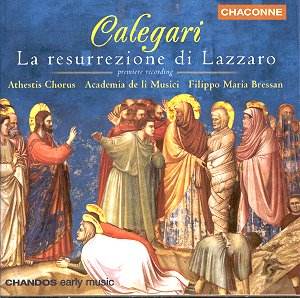An oratorio / cantata type composition by a little
known eighteenth century musician written when he was only twenty two
does not sound too promising. However, with this convincing performance
there is much to enjoy. In addition there is an informative "free"
CD ROM.
Calegari was a direct contemporary of Mozart who died
within a year of Schubert and Beethoven. His career thus straddled the
classical period and early romanticism. Stylistically his music reflects
this. La Resurrezione di Lazzaro is his earliest surviving work.
Although considering himself primarily a fashionable opera composer,
he wrote several sacred works (though none after 1801) and these tend
to be in a backward looking style. La Resurrezione di Lazzaro has
characteristics of the sacred musical play about it. The text is sung
by characters directly involved in the biblical drama taken from the
gospel of St John – Christ, Thomas, Magdelene, Martha and the risen
Lazarus himself – who actually interact. A chorus has a relatively minor
role.
To enjoy this work with modern ears it is as well to
get in the mood for a Metastasian drama. Metastasio, still alive at
the time of La Resurrezione, had been so influential as a librettist
that he had exerted a stranglehold on the style and formatting of musical
drama that was only just beginning to break down. Characteristics included
sophisticated poetic texts that were nevertheless clear and direct,
intensity of emotion achieved through restraint rather than a heart-on-sleeve
approach and the imparting of a worthy and communicable message.
These features are certainly present in this work.
After the conventional opening Sinfonia, admittedly one that could be
transferable to any work of the type, the drama gets straight to the
point with the words "Morte, morte" in a mournful chorus that
interacts with Martha. Christ soon makes his entry, asking why so much
grief? The story is well under way. But we have just hit another problem
for the listener. Christ is sung by a woman. At least it is on this
disc. In 1789 it was sung by a castrato in keeping with another Italian
tradition that was not to last too much longer. It may take getting
used to but if people can flock to see Hamlet played by a woman in contemporary
London, then maybe it is not such a problem. Clearly the dramatic centrepiece
of this work is the point at which Lazarus is "raised". It
is handled with powerful restraint, Christ calling on his Father for
help then issuing the order to "rise". Lazarus replies sleepily
then sings a number that gradually winds up in excitement as his situation
dawns. It sounds and feels like an animal waking from hibernation to
a spring day. The happy end of the work has a "death is defied"
theme and ends suitably with grand chorusing.
What carries this work from being a worthy curiosity
to being an enjoyable listening experience in its own right is the performance.
The Academia de li Musici is a distinguished early music outfit and
the chorus is supplied by the equally distinguished and versatile Athestis
Chorus. I like the playing of the Academia under Filippo Bressan very
much . They have achieved fine consistency of style, especially in the
matter of "authentic" reduced vibrato. Their clearly executed,
no-nonsense playing suits the work so well. The singers are another
matter. I am not an expert on singing style and technique of the period
and admit to not having read one of the most important treatise on the
subject written at the time, ironically by Calegari himself. Even so,
I cannot believe that the modern, constant, embedded vibrato employed
by the singers approximates to what I would have heard in 1789. The
singing of the soloists on this disc is at complete odds with the clarity
of style of both the players and the chorus. An additional problem on
passing is the difficulty the two sopranos singing Christ and Magdalene
have with their frequently low-lying parts. The bottom notes become
an audible, breathless struggle.
Notwithstanding my reservations about some of the soloists,
this disc is a welcome addition to that body of little known music in
a period so dominated by Mozart and Haydn, performed with care and commitment.
The CD ROM provided at no extra charge is nicely put
together, There is a considerable amount of text based material covering
historical and geographical background as well as details about the
work and its performance and audio backed libretto navigation. I particularly
liked an historical chart linking history, music and composer life details
for any given year.
John Leeman
See also review by Peter Grahame
Woolf

![]() Academia de li Musici /
Athesis Chorus / Filippo Maria Bressan
Academia de li Musici /
Athesis Chorus / Filippo Maria Bressan ![]() CHANDOS CHACONNE CHAN
0673 [78:11]
CHANDOS CHACONNE CHAN
0673 [78:11]